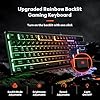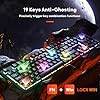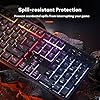Table of Contents
Introduction to Learning Piano Through Experimentation
Learning the piano is a journey that combines skill, creativity, and emotion. While traditional lessons have their place, many pianists have found a deeper understanding and connection with music through experimentation. This approach encourages explorative learning, where students not only follow structured exercises but also venture into the realm of personal creativity and discovery. It’s about leveraging curiosity and flexibility to enhance musical expression and technique.
Exploring Different Genres and Styles on the Piano
When learning the piano through experimentation, one effective approach is to dive into various musical genres and styles. This not only enhances your versatility as a pianist but also deepens your understanding of music. Below, we explore several key genres and styles that offer unique learning opportunities and techniques.
Logitech MK270 Wireless Keyboard and Mouse Combo for Windows, 2.4 GHz, 8 Multimedia Keys, PC, Laptop, Wireless Keyboard Compact Mouse Combo - Black
23% OffRedragon K521 Upgrade Rainbow LED Gaming Keyboard, 104 Keys Wired Mechanical Feeling Keyboard with Multimedia Keys, One-Touch Backlit, Anti-Ghosting, Compatible with PC, Mac, PS4/5, Xbox
20% OffLogitech K270 Wireless Keyboard for Windows, 2.4 GHz Wireless, Full-Size, Number Pad, 8 Multimedia Keys, 2-Year Battery Life, Compatible with PC, Laptop, Black
33% OffEPOMAKER x Aula F75 Gasket Mechanical Keyboard, 75% Wireless Hot Swappable Gaming Keyboard with Five-Layer Padding&Knob, Bluetooth/2.4GHz/USB-C, RGB (Light Blue, LEOBOG Reaper Switch)
13% OffClassical Music
Classical music is foundational in piano education, offering structured compositions that help in learning note reading, dynamic expressions, and complex rhythms. Start with simpler pieces by composers like Bach and Mozart, and gradually work towards more challenging works by Beethoven and Chopin. This genre emphasizes precision and technique, providing a strong basis for exploring other styles.
Jazz
Jazz piano is a great genre for exploring improvisation and complex chord structures. Key elements include swing timing, syncopation, and the use of seventh chords. Learning jazz often starts with mastering scales and modes, particularly blues and pentatonic scales, before moving to standards and chord progressions used in jazz.
Blues
The blues style is closely related to jazz and focuses heavily on emotional expression and call-and-response patterns. Blues piano is characterized by its use of the blues scale, and classic 12-bar blues progressions. Experimenting with blues can vastly improve your rhythmic feel and improvisational skills.
Rock and Pop
Rock and pop styles on the piano are great for learning about song structure, melodic hooks, and accompaniment patterns. These genres often make use of repeating chord progressions and catchy melodies, making them accessible for beginners. Incorporating elements of rock and pop can make practice sessions more engaging and fun.
Logitech MK270 Wireless Keyboard and Mouse Combo for Windows, 2.4 GHz, 8 Multimedia Keys, PC, Laptop, Wireless Keyboard Compact Mouse Combo - Black
23% OffRedragon K521 Upgrade Rainbow LED Gaming Keyboard, 104 Keys Wired Mechanical Feeling Keyboard with Multimedia Keys, One-Touch Backlit, Anti-Ghosting, Compatible with PC, Mac, PS4/5, Xbox
20% OffLogitech K270 Wireless Keyboard for Windows, 2.4 GHz Wireless, Full-Size, Number Pad, 8 Multimedia Keys, 2-Year Battery Life, Compatible with PC, Laptop, Black
33% OffEPOMAKER x Aula F75 Gasket Mechanical Keyboard, 75% Wireless Hot Swappable Gaming Keyboard with Five-Layer Padding&Knob, Bluetooth/2.4GHz/USB-C, RGB (Light Blue, LEOBOG Reaper Switch)
13% OffContemporary
Contemporary piano music spans a wide range of styles but generally focuses on modern composition techniques and sounds. This genre often incorporates elements from other styles and uses technology, such as synthesizers and digital effects, to create unique textures and sounds. Exploring contemporary music can help develop creativity and a personal style.
New Age and Ambient
New age and ambient piano music emphasize tone, atmosphere, and texture over traditional structure. These styles are perfect for pianists interested in meditative and therapeutic playing. They often require a delicate touch and good control over dynamics and tempo, providing a unique challenge that differs from more rhythmically intense music.
Gospel and Worship
Gospel piano incorporates elements of jazz and blues but with a focus on spirituals and hymns. Worship piano typically involves leading or accompanying congregational singing, requiring skills in chord prediction and improvisation within more structured frameworks. Both styles are excellent for developing a sense of community and emotional play.
By experimenting with these different genres and styles, pianists can expand their musical vocabulary, improve their technical skills, and discover personal musical preferences that shape their playing style.
Understanding Basic Music Theory
Begin by solidifying your understanding of basic music theory, including scales, chords, and chord progressions. Knowledge of these fundamentals is essential for creating effective and harmonious arrangements.
Listening and Analyzing
Listen to various types of piano music and pay close attention to different styles and techniques. Analyze how different artists approach melody, harmony, and rhythm. This will inspire and inform your own arrangements.
Arranging a Melody
Start with a simple melody, either one you’ve created or a familiar tune. Think about how you can change the melody’s rhythm, tempo, or even mode to make it unique. Experiment with transposing the melody to different keys to see how it impacts the emotion and feel of the piece.
Adding Harmony
Incorporate chords to support the melody. Start with basic triads, and then experiment with more complex structures like seventh chords or extended chords. Pay attention to the emotional effects different chords have when paired with your melody.
Rhythmic Variations
Change the piece’s feeling by altering its rhythm. Try different time signatures or syncopation to add interest. Sometimes a subtle change in rhythm can lead to a completely different style or feel.
Experimenting with Texture
Texture refers to how many layers of sound are heard at once, and the range of pitch and volume. Experiment by adding a bass line, using arpeggios, or playing chord inversions. Utilize different dynamics and articulations to vary the texture.
Using Advanced Techniques
Once comfortable, start incorporating more advanced techniques like counterpoint or modulation. These methods can add considerable depth and complexity to your arrangements.
Recap and Revision
After creating your arrangement, take the time to play it through and see how it feels. Make adjustments based on what you hear. It’s often beneficial to record yourself so you can analyze your performance and identify areas for improvement.
Sharing and Feedback
Finally, share your arrangement with others to get feedback. This can provide you with new insights and suggestions that can further refine your skills in arranging music for the piano.
Experimenting with Tempo
One effective way to learn piano through experimentation is by playing with different tempos. Tempo, the speed at which a piece is played, profoundly affects a piece’s character and feeling. To begin experimenting with tempo, start by learning a piece at the recommended tempo. Once comfortable, begin to vary the speed:
Make detailed notes on how changing the tempo affects your perception and execution of the piece. This process not only improves technique but also deepens musical expression.
Experimenting with Dynamics
Dynamics refer to the loudness or softness of the music being played. Mastering dynamics is crucial for expressive playing and can greatly enrich your piano learning experience. Here’s how you can experiment:
Document how these experiments with dynamics alter your interaction with the music. This kind of exploration not only sharpens technical skills but also enhances interpretative abilities.
Incorporating Unconventional Techniques for Learning Piano
Using Video Game Software
Modern technology provides unconventional methods such as video game learning tools, like Synthesia, which can make learning piano more engaging. These games often use a falling note interface, similar to Guitar Hero, which can help associate note positions with keyboard layout indirectly.
Experimenting with Different Genres
Branch out from classical pieces to explore genres like jazz, pop, or electronic music. This not only broadens musical appreciation but enhances understanding of various keyboard techniques and styles. Such cross-genre experimentation often introduces diverse rhythmic and chord patterns, which can advance playing skills.
Learning Through Ear Training
Focus on developing your ear to recognize pitch and harmonic relationships by playing along with recordings and attempting to replicate them without sheet music. This approach enhances auditory skills and encourages a more intuitive connection with the instrument.
Using Apps and Digital Resources
There are numerous apps designed to help with learning piano, offering interactive lessons, real-time feedback, and customized exercises. Apps like Flowkey and Simply Piano listen to your play and provide immediate feedback on timing and accuracy, making practice sessions more productive.
Composing Your Own Music
Start creating simple melodies and gradually build complexity. Composing urges you to think critically about music theory and application, fostering a deeper understanding of chord progressions, scales, and melody formation.
Improvisation Exercises
Set aside regular practice time for improvisation. Start with a simple chord progression and experiment with varying melodies over it. Improvisation is a powerful tool for understanding musical structure and theory in a dynamic and practical context.
Finding Your Unique Voice on the Piano
Developing a distinct musical identity on the piano involves experimentation and personal reflection. Understanding and unleashing your unique voice is crucial in your journey as a pianist. Here are some ways to explore and refine your individual sound:
Experiment with Different Genres
One of the best ways to discover your unique voice is by not limiting yourself to only one musical genre. Dive into classical, jazz, blues, pop, and even electronic music to find what resonates with you. Each genre offers different stylistic elements and playing techniques that can shape your personal style.
Incorporate Improvisation
Improvisation is a powerful tool for self-expression on the piano. Begin with simple improvisational exercises over chord progressions or blues scales. Gradually, incorporate more complex structures or even improvisational dialogues with other musicians. This process enhances your instinctual response and contributes to developing a voice that’s uniquely yours.
Explore New Techniques and Textures
Varying your touch and technique can significantly affect the tone and feel of your music. Experiment with different piano techniques such as staccato, legato, and the use of sustain pedals. Explore diverse textural sounds by using methods like muting strings with your hand, or experimenting with electronic effects if you have access to a digital piano.
Reflect on Your Emotions and Experiences
Much of what makes your piano voice unique will come from your personal experiences and emotional landscape. Reflect on these elements and explore ways to express them through your music. This could involve creating musical motifs that represent specific feelings or memories, or simply letting your mood influence your playing style.
Listen Critically and Analytically
Listening is just as important as playing when it comes to developing your musical voice. Listen critically to other pianists and musicians, analyzing what you like about their style and what you might do differently. Use this analysis to refine your playing and incorporate elements that speak to you personally.
Seek Feedback and Collaborate
Engage with teachers, peers, or mentors and seek constructive feedback on your playing. Collaboration with other musicians can also provide new insights and inspiration. These interactions can help you see your playing in a new light and push you to further develop your unique voice.
Conclusion
In conclusion, learning the piano through experimentation is a dynamic and personalized approach that cultivates creativity and deepens musical understanding. By embracing experimentation, learners can discover techniques that resonate uniquely with them, leading to a more intuitive and gratifying musical journey. This approach not only accelerates skill development but also enhances the joy of musical exploration. Therefore, experimenting with various methods, styles, and compositions is crucial for those aspiring to become versatile and expressive pianists.






































